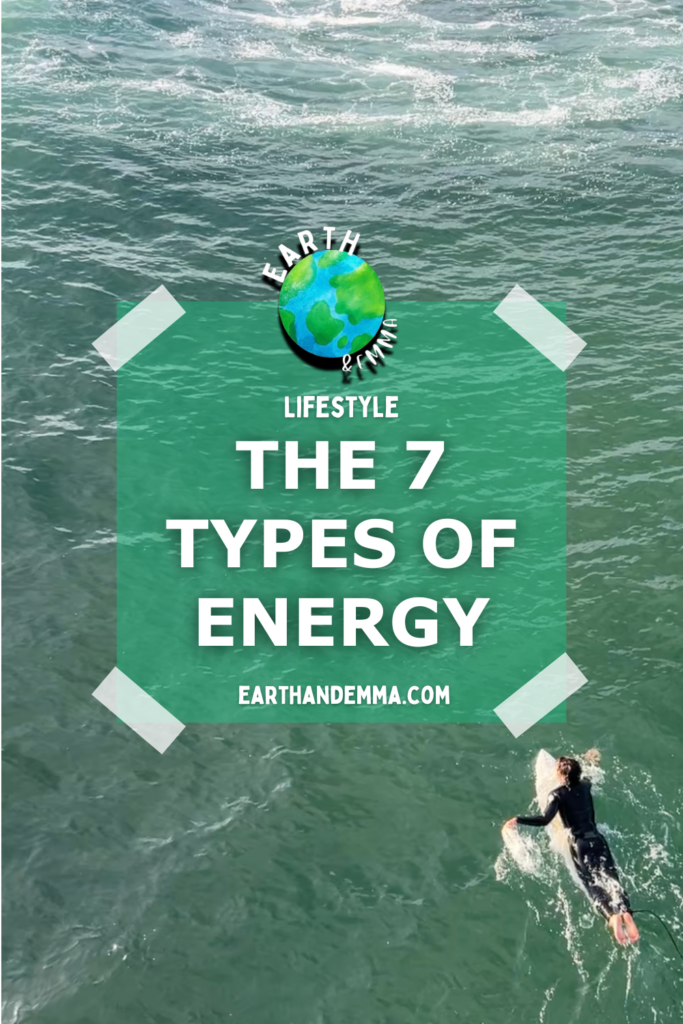
Have you ever felt exhausted after hours at the computer, only to feel fired up the moment you start your workout? Or drained after a full day with colleagues, yet craving a long-distance call with your best friend? Maybe you feel depleted after a deep doomscroll, yet a pull to go outside and reconnect with nature. How can you supposedly feel empty after one thing, while seemingly having plenty of energy for another? A combination of tired and wired? That polarity is exactly what this blog post will explore.
If you haven’t read 11 Energy-Boosting Habits yet, I highly recommend checking it out after reading this one. Our society has normalized some recurring habits that, when consumed, are energy vampires, like processed foods, prolonged sitting, sleeping in, and toxic social dynamics. The rejuvenating habits in that post are designed to transform those energy suckers into flourishing gardens you can tend to—and through them, rediscover a life of color.

The 7 Types of Energy and Where We Get Our Rest
Our energy levels do not come from a singular tank that fluctuates randomly throughout the day. In reality, we have various energy “buckets”—seven to be exact—that gain, store, and spend energy in different ways. Understanding the inner workings of your buckets—how they fill, how you feel when they’re low, and how each is significant to you—will allow you to make small changes that lead to positive transformations in your life.
Let’s get into it.
In this post:

What Are the 7 Energy Buckets?
Every action in life requires energy. If you read the Environmental Science Lesson on Energy, you recall that energy is defined as the ability to do work—universally. So, to carry out an action, there’s a need for the ability to do work. This concept is straightforward and leaves little room for confusion. However, the types of energy and their significance to a person can vary greatly.
Though each type of energy can be further refined, we’ll focus on seven comprehensive categories. Throughout this blog, I’ll refer to each type as a “bucket” to illustrate the metaphor of your energy levels filling and emptying. Each bucket represents a different kind of “work,” and each fills and empties uniquely.
The seven buckets are physical, spiritual, mental, social, emotional, creative, and sensory. Simply becoming aware of these different types of energy can help your brain tune in more deeply to your body’s signals, potentially surfacing with a greater balance in each bucket.
Physical
Movement energy.
Spiritual
Intuitive energy.
Mental
Thought energy.
Social
Connecting energy.
Emotional
Feeling energy.
Creative
Explorative energy.
Sensory
Stimulated energy.
How Does Each Bucket Empty?
Next, we’re going to scratch the surface on what kinds of “work”—or activities—you spend energy on. As each example is introduced, you may begin to recognize some that you engage in and start reflecting on how they make you feel.
When you participate in any activity, you are spending energy. Focusing too much on one type of activity can drain a specific bucket, but developing an awareness of how to spread your energy across all your buckets can help you better understand yourself—and leave you with more to give.
Getting sufficient sleep won’t necessarily fix the toxic friendship drama you’ve been caught in for weeks, or make that pile of bills on your kitchen table disappear. When you’re depleted in one area, you might feel drawn toward another—your body’s way of tapping into unused potential energy. Intrigued? Let’s dive deeper.
Physical Energy
Moving our bodies releases physical energy. There are countless ways to incorporate movement into your day, and it is essential to prioritize daily physical activity for its necessary physical and mental benefits. Some movements require more energy than others—like weightlifting compared to walking—and generally, the more energy released, the more recovery is needed. Finding a balance between different types of movement in your routine can help you feel your best without flirting with burnout.
Spiritual Energy
Spiritual energy is used when we connect with a higher power, tune into our intuition, or engage with any form of faith. Harnessing and sustaining spiritual energy often leads to a deeper understanding of the self—and, in turn, the six other energy buckets. However, engaging with beliefs you don’t resonate with, feeling disconnected from your spirituality, or delving too deeply down a spiritual path without incorporating external balance can leave you spiritually depleted.
Mental Energy
Mental energy is required for cognitive tasks. This includes schoolwork, job responsibilities, budgeting, scheduling, doing taxes, adding receipts—essentially, any task that requires brainpower. This is a commonly exhausted bucket, especially in America, because overworking and burnout are often glamorized. Depleted mental energy leaves you with less capability to prioritize your tasks and complete what matters to you to the best of your ability.
Social Energy
Different forms of social interaction use different amounts of energy. In general, engaging with others—especially acquaintances or unfamiliar people—tends to drain our social energy. Pay attention to the people you spend time with who drain your social energy more than others do, and reflect on those relationships and their significance in your life. In today’s world, even passive social media use can take a toll, particularly when it involves frequent, casual check-ins.
Emotional Energy
Emotional energy is used when we process our emotions. Life is full of highs and lows, and feeling our feelings is a vital part of the human experience. It can be challenging—especially if trauma has built emotional blocks—but working through those mental “firewalls” can help you experience your emotions more fully and get to know yourself more deeply.
If you’re feeling a mix of emotions or going through a period of intense emotional processing, your emotional energy bucket may run low. Learning to process emotions—rather than suppress or ignore them—can lead to healthier emotional energy levels overall.
Creative Energy
Creative expression means different things to different people, but engaging in outlets creative to you is how creative energy is spent. Hobbies, self-growth, problem-solving, fashion, art, deep thinking, brainstorming, and finding flow are just some of the mediums for using your creative energy. Though creative energy is generally a positive endeavor, too much time spent creatively can burn you out and require a break from creative activities.
Sensory Energy
Our brains are designed for a world that is a lot slower and softer than the one humanity has created. Nature’s pace is what we are programmed to feel peace and contentment in, yet many of us are caught up in experiences that are quite the opposite and reap endless consequences, some even without our awareness. The surplus of stimulants in this artificial and digital world directly leads to a regular exhaustion of sensory energy.
Detecting and processing sights, sounds, tastes, smells, touch, and information is how sensory energy is spent. It’s safe to assume many of us burn through our sensory budget before lunch. When your brain is overloaded while running on empty, the exhaustion is even more intense.
As you can see, many energy pathways contribute to how we feel overall. Each bucket fills and drains from different experiences. Recognizing where you need rest or recharge is key to restoring balance and getting back on your feet when you’re running low.

How Does Each Bucket Fill?
Now that we understand how different types of tiredness can feel, let’s explore how each energy bucket can be replenished.
Physical
Incorporating both resistance and cardiovascular training into your routine is essential for bone and muscle strength, heart health, and long-term wellness. Choose movement activities that meet these needs and bring you joy. Motivation may come and go, but determination will take you further. Set achievable goals, celebrate small wins, and fall in love with the process.
Replenish this bucket by:
– Getting several nights of quality sleep
– Stretching or flowing through yoga
– Getting a massage
– Meal prepping a few nutrient-dense meals
– Taking a “color walk” (choose a color and look for it on your walk)
– Drinking water with a pinch of salt
– Taking a dip in the ocean or practicing cold therapy
Spiritual
Spiritual energy is replenished when you connect with your inner self, a higher power, or a sense of purpose. These quiet, reflective moments foster deeper understanding and inner peace.
Try:
– Meditation
– Spending time in nature
– Embracing silence
– Swimming in natural water
– Talking with a close friend
– Journaling
– Practicing breathwork
– Dancing freely
– Enjoying a self-care night
– Cooking a family recipe
– Reconnecting with a childhood hobby
Mental
This bucket often needs a reset. Start by reevaluating your schedule to strike a healthier balance. The key is to build in intentional, restorative mental breaks—ones that suit you, not just what’s trending online.
Refill by:
– Taking mini breaks throughout your workday
– Going on walks without earbuds or stimulation
– Exercising or moving outdoors at least once a day
– Engaging in “thoughtless” hobbies like painting, knitting, or skateboarding
– Leaving your workspace during lunch
– Keeping your bedroom a cognitive-free zone for better sleep
– Pursuing work or studies that truly energize you
Emotional
If you’re emotionally drained, how you refill your bucket depends on the source of depletion.
If you’re overwhelmed by your own emotions:
– Call a loved one while taking a walk
– Meet someone in person, ideally outside
If you’ve been absorbing other people’s emotions:
– Retreat to a safe space and fully unload
– Then reflect with journaling, therapy, voice notes, or videos
– Pet a dog, hug someone you love, or watch home videos to reconnect and uplift
Social
When your social battery is depleted—from social media or real-life interactions—it’s time to turn inward. Solo time is key to reconnecting with yourself, especially through activities that others might not “get,” but that hold deep personal meaning.
Recharge by:
– Having a self-care night alone
– Reaching out to your closest friend
– Cooking a fun recipe just for yourself
– Coloring in a coloring book
– Scheduling time for your hobbies
– Getting lost in a book
– Turning your phone on Do Not Disturb and putting it away
– Allowing time for slow, complete morning and night routines
Creative
When your creative bucket is low, brainstorming ways to refill it can feel paradoxical—lack of inspiration often is the problem.
Ideas to get started:
– Try one new thing in your routine
– Spend time in nature
– Visit a museum or go on a hike
– Play an instrument
– Listen to new music
– Browse a thrift store
– Attend a live performance or art gallery
– Shop at a farmer’s market
– People watch in a public space
– Take a spontaneous day trip
– Get messy with art supplies
– Rearrange your room
– Make a vision board
– Watch a documentary
– Plan a vacation
– Catch up with a long-lost friend
– Work from a new environment for a day
Sensory
In our overstimulated world, having go-to tools to soothe your senses can help you recover more quickly. If you’re not sure what works for you yet, here are a few things to try:
– Take a nap
– Go for a swim
– Remove electronic stimulation
– Wash your sheets
– Take deep breaths with your eyes closed
– Walk barefoot on grass or sand
– Release physical tension through movement
– Take a full “everything shower”
– Do your laundry and clean your space
– Check small tasks off your to-do list
Now that you understand how your energy levels are affected by different areas of life, check out the 11 Energy-Boosting Habits post and start your energy-replenishing journey!



